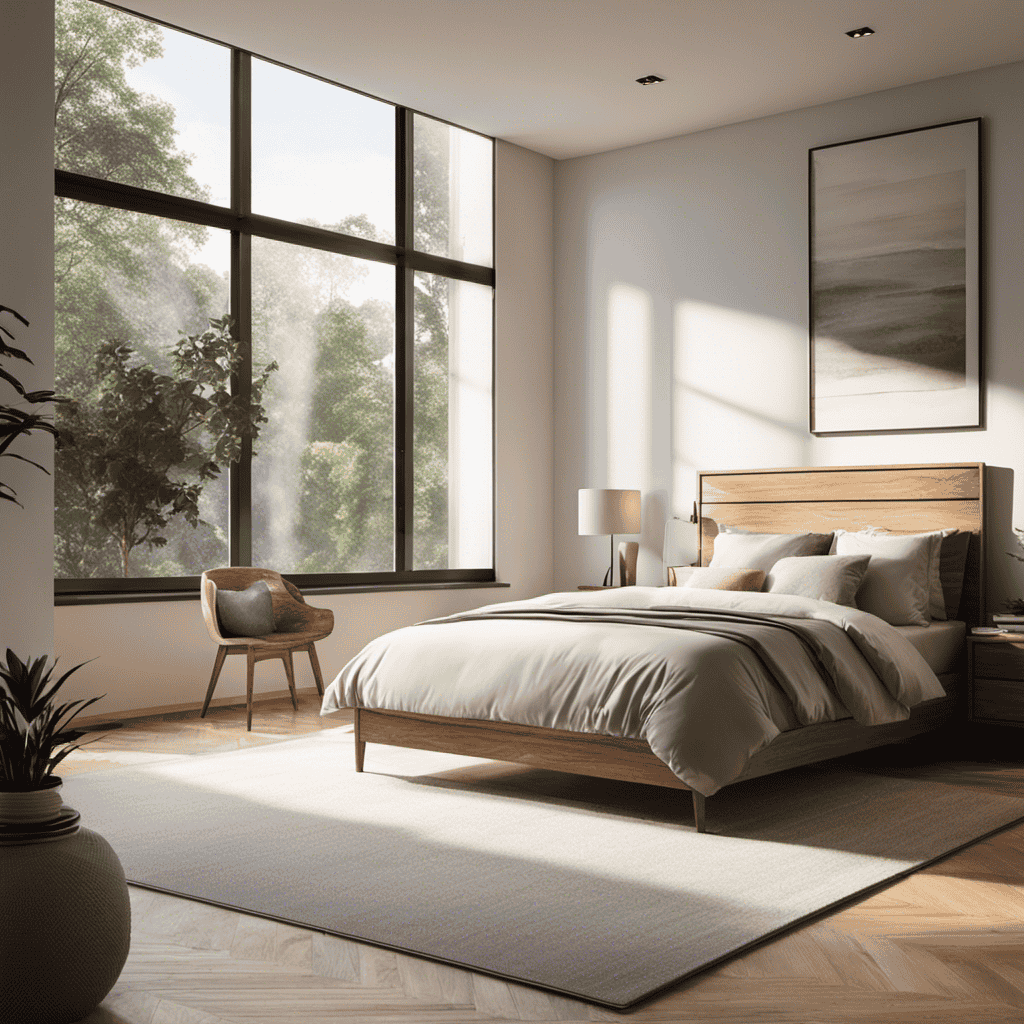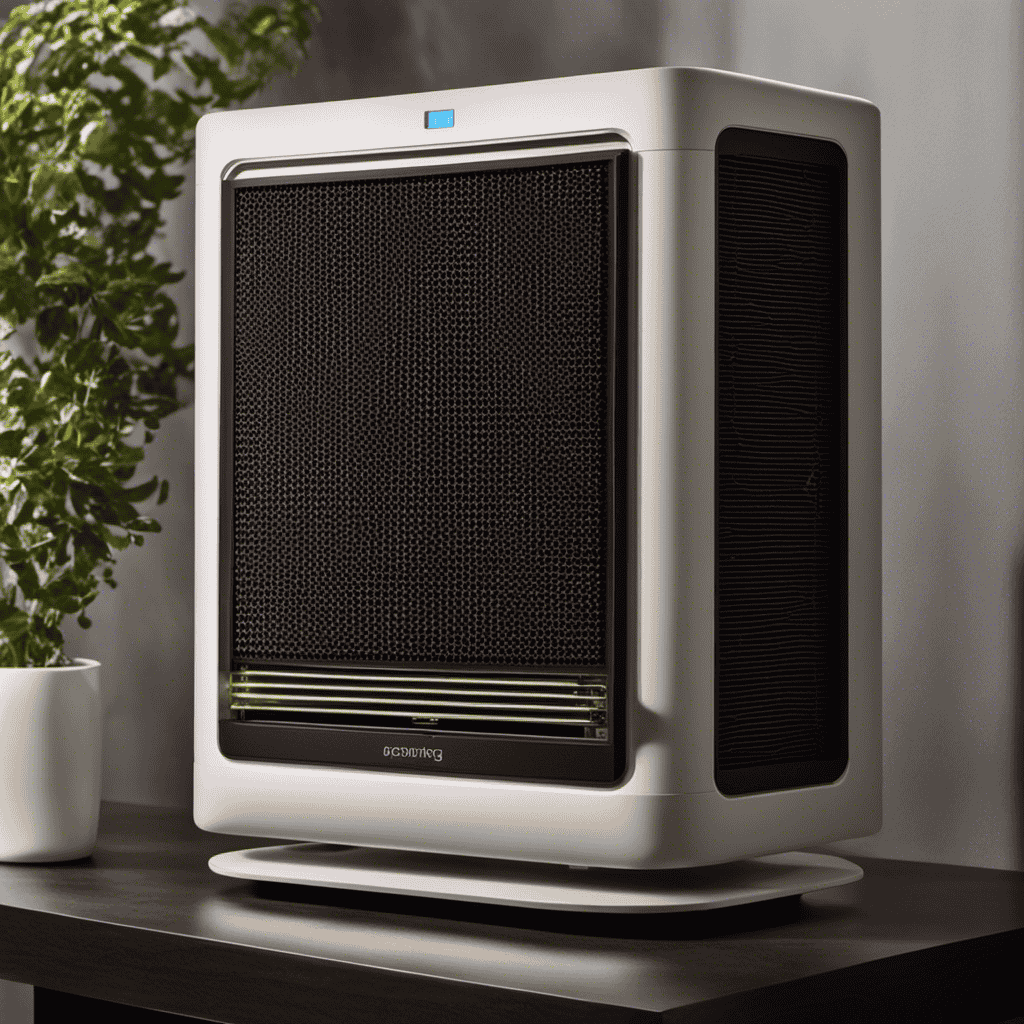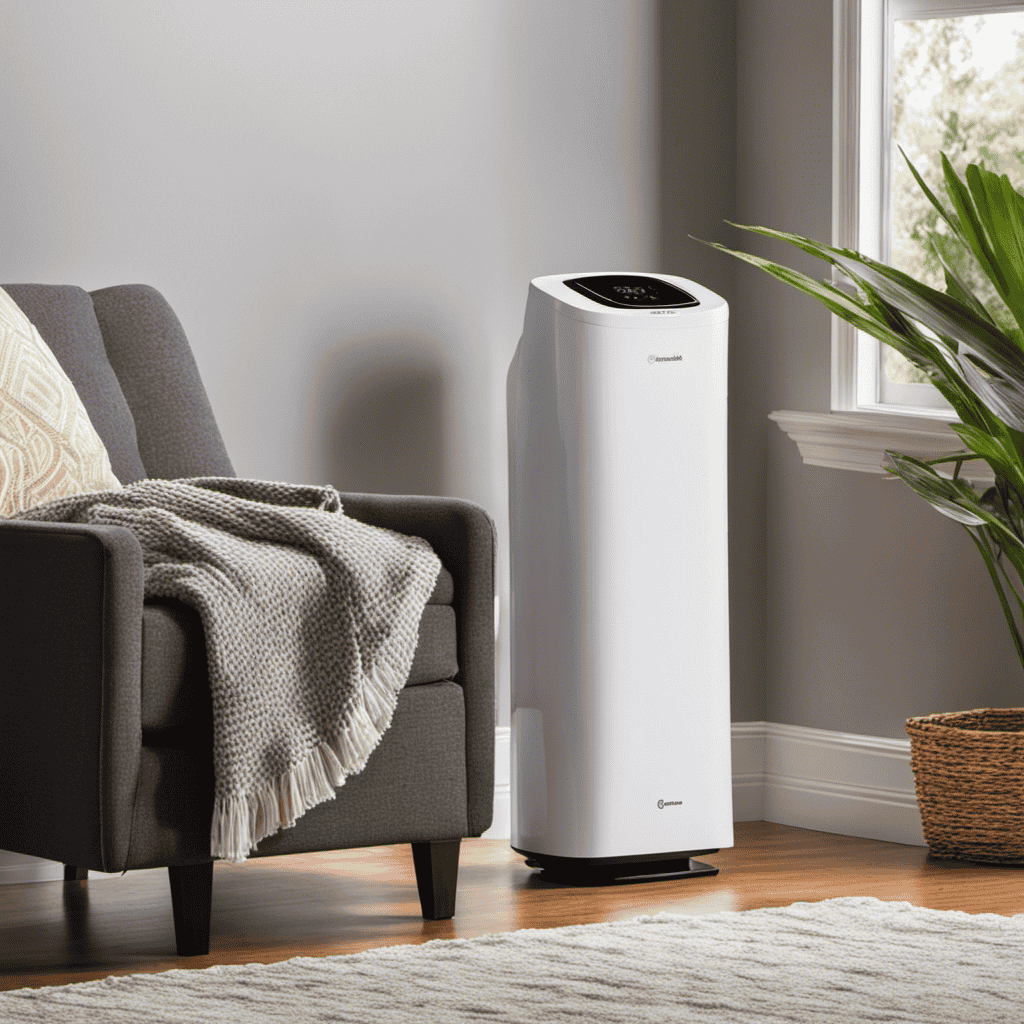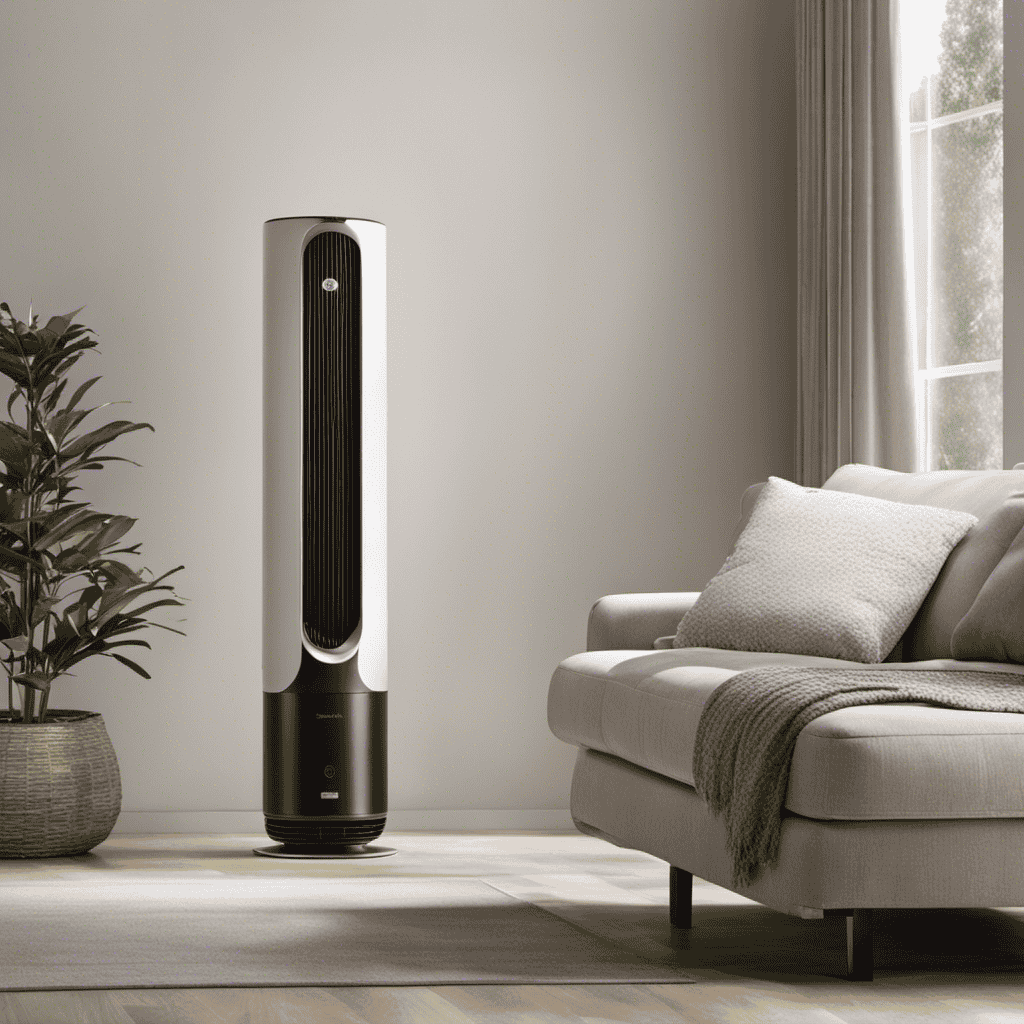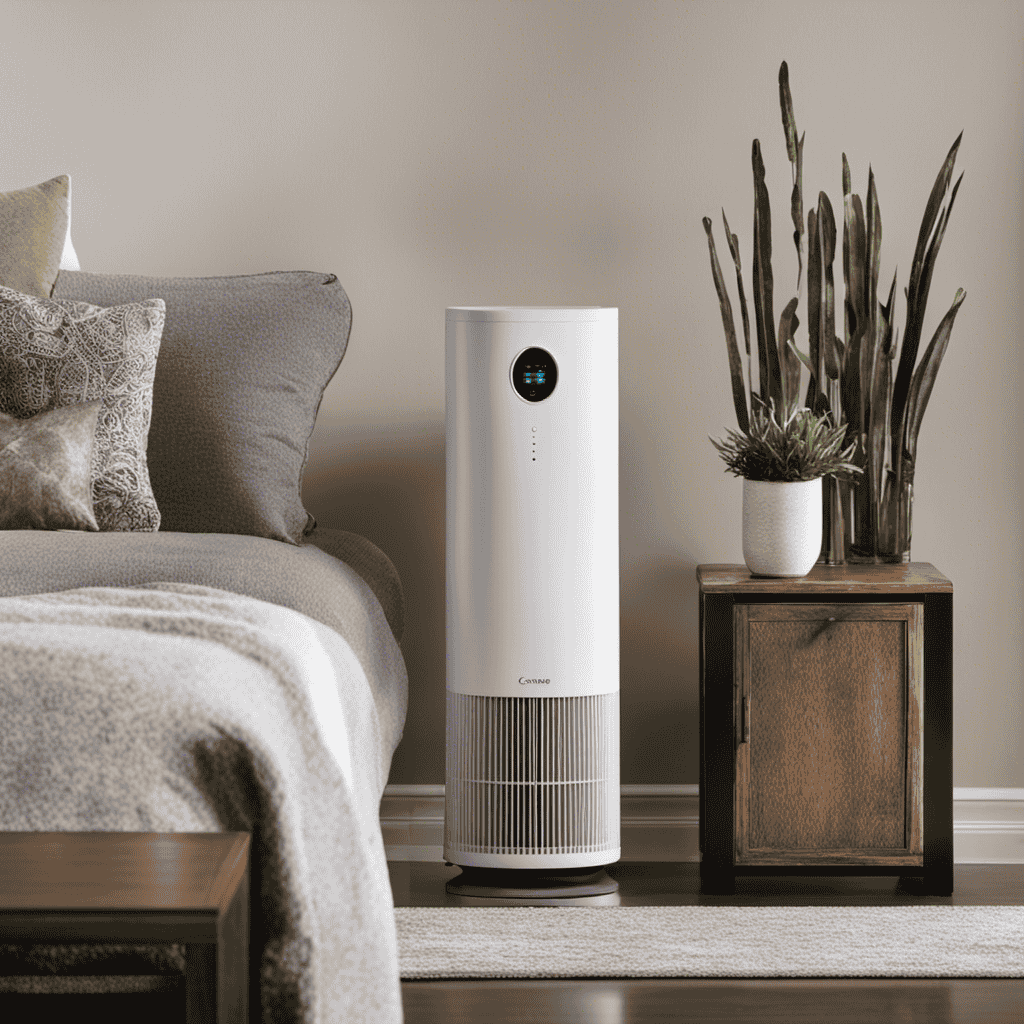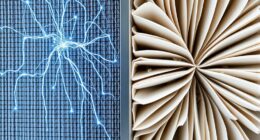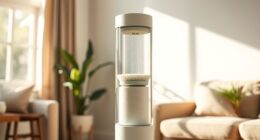Hello there! Have you ever wondered how long it takes for an air purifier to start working effectively? I have all the information you need.
In this article, we’ll dive into the factors that affect the purification speed, such as the air purifier’s CADR rating and the size of the room.
We’ll also explore how different types of air pollutants and filters can impact the time it takes to purify the air.
So, let’s get technical and find out the realistic expectations for the time it takes an air purifier to work its wonders!
Key Takeaways
- The effectiveness of an air purifier depends on factors such as room size, type of pollutants, efficiency of the purifier, and clean air delivery rate (CADR).
- Different air purifier technologies, such as HEPA filters and activated carbon filters, are effective at removing airborne particles, odors, and chemicals.
- Noticeable improvement in allergies may take a few days or weeks, but air purifiers can start purifying the air in as little as 30 minutes.
- Air purifiers take a few hours to eliminate smoke and odors, and larger purifiers with powerful fans and filters are more efficient in cleaning the air.
Factors That Affect the Time It Takes for an Air Purifier to Work
One of the factors that affects how long it takes for an air purifier to work is the size of the room you’re using it in. The larger the room, the longer it may take for the air purifier to effectively clean the air.
Additionally, the noise levels of an air purifier can impact its efficiency. Some air purifiers produce loud noise levels, which may indicate a higher airflow rate and faster air cleaning. On the other hand, quieter air purifiers may have a slower air cleaning rate.
Another factor to consider is the impact of the air purifier on energy consumption. Air purifiers with higher airflow rates and larger room coverage tend to consume more energy. Therefore, it’s essential to choose an air purifier that suits the size of your room and meets your noise level preferences, while also considering its impact on energy consumption.
Understanding these factors will help you make an informed decision when selecting an air purifier that meets your needs.
Now, let’s delve into understanding the air purifier’s CADR rating.
Understanding the Air Purifier’s CADR Rating
When it comes to air purifiers, understanding the CADR rating is crucial.
The CADR rating, or Clean Air Delivery Rate, measures the speed and effectiveness of an air purifier in removing specific pollutants from the air.
A higher CADR rating signifies a faster rate of air purification, making it an important factor to consider when choosing an effective air purifier for your needs.
CADR Rating Significance
To truly understand the significance of CADR ratings, you should know that they indicate how quickly an air purifier can clean the air in a given space. CADR, or Clean Air Delivery Rate, is an important metric for determining the efficiency of an air purifier. It measures the volume of clean air that an air purifier can deliver per minute.
A higher CADR rating means that the air purifier can clean the air faster. Several factors can affect the purification time of an air purifier. The size of the room, the level of pollutants present, and the fan speed are some of the key factors.
A larger room with high pollutant levels will require an air purifier with a higher CADR rating to clean the air effectively and in a shorter amount of time.
Speed of Air Purification
The speed at which an air purifier cleans the air can be affected by factors such as room size, pollutant levels, and fan speed. To determine the air purification speed of an air purifier, it is essential to consider the Clean Air Delivery Rate (CADR) rating.
This rating measures the volume of clean air that an air purifier can deliver per minute. The higher the CADR rating, the faster the air purifier can remove pollutants from the air.
Additionally, the efficiency of an air purifier plays a crucial role in its speed. An efficient air purifier can effectively capture and remove airborne particles, such as dust, pollen, and pet dander, improving the overall air quality in a shorter amount of time.
Therefore, when selecting an air purifier, it is important to consider both the CADR rating and the efficiency of the device to ensure optimal air purification speed.
Choosing Effective Air Purifier
Selecting an efficient air purifier involves considering factors such as CADR rating and device efficiency to ensure effective air purification. When it comes to air purifier brands, it’s important to compare costs and features to find the best option for your needs. Here are some key considerations:
- CADR Rating: Look for a higher Clean Air Delivery Rate (CADR) to ensure faster and more efficient air purification.
- Filter Efficiency: Check the device’s filter efficiency, especially for capturing particles like pollen, dust, and pet dander.
- HEPA Filters: High-Efficiency Particulate Air (HEPA) filters are known for their effectiveness in removing airborne particles.
- Activated Carbon Filters: These filters help eliminate odors and harmful gases.
By considering these factors, you can choose an air purifier that provides optimal air purification.
Now, let’s explore the importance of room size in air purification speed.
The Importance of Room Size in Air Purification Speed
When it comes to air purifiers, you’ll find that room size plays a crucial role in how quickly they can purify the air. The impact of room size on purification time can vary significantly.
A larger room requires a more powerful air purifier to effectively clean the air within a reasonable time frame. This is because the air volume in a larger room is greater, which means the air purifier needs more time to filter and circulate all the air in the room.
On the other hand, in a smaller room, the air purifier can work more efficiently and purify the air at a faster rate. Therefore, when choosing an air purifier, it is essential to consider the size of the room to ensure optimal purification performance.
How the Type of Air Pollutants Can Impact Purification Time
In my previous discussion, I emphasized the significance of room size when it comes to air purification speed. Now, let’s explore how the type of air pollutants can affect the time it takes for an air purifier to work effectively.
When it comes to different air purification technologies, it’s crucial to understand their impact on purification time. Here are two key factors to consider:
-
Pollutant Size:
- Larger particles like dust and pollen are easier to capture and remove from the air. This means that air purifiers can work relatively faster in removing these pollutants.
- Smaller particles like volatile organic compounds (VOCs) and bacteria can be more challenging to eliminate. Hence, the purification process might take longer.
-
Air Purifier Efficiency:
- Different air purifiers have varying effectiveness in removing specific pollutants. For instance, some models excel at removing smoke particles, while others are more efficient at reducing allergens.
- Choosing an air purifier that effectively targets the specific pollutants you want to eliminate can significantly impact the purification time.
Moreover, the effectiveness of air purifiers on respiratory symptoms is worth considering. Research has shown that air purifiers can reduce symptoms related to asthma, allergies, and other respiratory conditions. Therefore, selecting the right air purifier can not only improve air quality but also alleviate respiratory discomfort.
The Role of Air Purifier Filters in Purification Speed
To improve the speed of your air purification process, consider regularly replacing the filters in your air purifier. Filters play a crucial role in trapping and removing airborne pollutants, ensuring that the air you breathe is clean and healthy. Over time, filters can become clogged with particles, reducing their efficiency and slowing down the purification process. By replacing the filters at the recommended intervals, you can maintain optimal airflow and enhance the speed at which your air purifier works.
To illustrate the impact of room size on purification speed, consider the following table:
| Room Size (sq ft) | Recommended Air Purifier Capacity (CADR) | Purification Time |
|---|---|---|
| 100-300 | 100-200 | 30 minutes |
| 300-500 | 200-300 | 45 minutes |
| 500-800 | 300-400 | 60 minutes |
As you can see, the larger the room, the higher the recommended CADR and the longer it will take for the air purifier to fully clean the air. Additionally, the fan speed setting of your air purifier also plays a significant role in the purification speed. In the next section, we will explore the significance of the air purifier’s fan speed setting and how it can impact the overall efficiency of the purification process.
The Significance of the Air Purifier’s Fan Speed Setting
The fan speed setting of an air purifier determines how quickly it filters pollutants. This feature is important to consider when using an air purifier because the higher the fan speed setting, the faster the purification speed.
There are several key points to understand the significance of the air purifier’s fan speed setting. Firstly, higher fan speed settings result in increased airflow, allowing more air to pass through the purifier. This leads to faster purification.
Secondly, the higher the fan speed, the more efficiently the air purifier can capture and remove pollutants such as dust, allergens, and smoke particles.
It is important to note that higher fan speed settings may generate more noise. However, many air purifiers offer multiple fan speed options to balance purification speed and noise levels.
The Impact of Air Purifier Placement on Effectiveness
In order to optimize the effectiveness of an air purifier, the placement of the device plays a crucial role. The impact of air circulation on the purification process cannot be underestimated. When the air purifier is strategically positioned, it can ensure maximum coverage and efficiency in cleaning the air.
To illustrate the importance of proper placement, consider the following table:
| Placement Location | Impact on Effectiveness |
|---|---|
| Near the source | Highly effective |
| In the center of the room | Moderately effective |
| Near the door or window | Less effective |
| Behind furniture | Ineffective |
| In a closed space | Ineffective |
As shown in the table, placing the air purifier near the source of pollutants yields the highest effectiveness. Additionally, positioning it in the center of the room allows for better distribution of clean air. Conversely, placing the device near doors or windows, or behind furniture, hinders its ability to purify the air effectively.
Understanding the impact of air purifier placement optimization and air circulation on effectiveness sets the stage for the subsequent section, which explores the influence of indoor air quality on purification time.
The Influence of Indoor Air Quality on Purification Time
Improving indoor air quality can significantly reduce the time it takes for the air purifier to effectively clean the room. One factor to consider is the influence of humidity on purification time.
-
Humidity affects the efficiency of air purifiers. High humidity levels can cause mold and mildew growth, which can clog the filters and reduce their effectiveness. This can increase the time it takes for the air purifier to clean the air.
-
On the other hand, low humidity levels can cause airborne particles to become more airborne, making it easier for the air purifier to capture them. This can reduce the purification time.
Another important factor to consider is the impact of air purifier size on effectiveness.
-
Larger air purifiers have more powerful fans and are capable of cleaning larger rooms more quickly.
-
Smaller air purifiers may take longer to effectively clean the air in larger rooms, as their capacity may not be sufficient.
Understanding these factors is crucial in choosing the right air purifier for your space.
Now let’s explore the relationship between air purifier capacity and purification speed.
The Relationship Between Air Purifier Capacity and Purification Speed
When choosing an air purifier, you’ll want to consider how the capacity of the purifier affects how quickly it can clean the air.
The capacity of an air purifier refers to its ability to process a certain volume of air within a specific time frame. Generally, the larger the capacity, the faster the purification speed.
To choose the appropriate size for your needs, it is important to understand the purification process. Air purifiers work by drawing in air and passing it through a series of filters to remove contaminants such as dust, pollen, and pet dander.
The larger the capacity, the more air can be processed at once, resulting in a quicker purification time. It is crucial to consider the size of the room or area where the air purifier will be used, as well as the level of pollutants present, to ensure optimal performance.
The Effectiveness of Different Air Purification Technologies
Different air purification technologies have varying levels of effectiveness in removing contaminants from the air. When comparing different purification technologies, it is important to consider their ability to capture and eliminate pollutants.
Here is a comparison of two popular air purification technologies:
-
High-Efficiency Particulate Air (HEPA) Filters:
-
Highly effective in removing airborne particles such as dust, pollen, and pet dander.
-
Can capture particles as small as 0.3 microns with an efficiency of up to 99.97%.
-
Activated Carbon Filters:
-
Excellent at removing odors, chemicals, and volatile organic compounds (VOCs).
-
Absorbs these pollutants through a process called adsorption, which traps them in the carbon’s pores.
It is important to note that the effectiveness of an air purifier is also influenced by its size. A larger air purifier generally has a higher Clean Air Delivery Rate (CADR) and can cover a larger area, ensuring more effective purification.
Therefore, when choosing an air purifier, consider both the purification technology and the size to maximize its effectiveness in removing contaminants from the air.
How Long It Takes for an Air Purifier to Remove Common Allergens
When it comes to immediate allergy relief, it is important to consider the capabilities of an air purifier.
Some air purifiers are specifically designed to provide immediate relief by capturing and eliminating allergens in the air. However, the time it takes for noticeable improvement may vary depending on factors such as the size of the room and the level of allergen concentration.
Therefore, it is essential to choose an air purifier that is not only effective in providing immediate relief but also capable of delivering noticeable improvement over time.
Immediate Allergy Relief
For faster relief from allergies, an air purifier typically takes around 30 minutes to start working. It quickly filters the air, removing common allergens such as pollen, dust mites, and pet dander. Once activated, the air purifier goes to work, continuously trapping and eliminating these irritants.
Here’s what you can expect from an air purifier in terms of immediate relief and effectiveness duration:
-
Immediate Relief:
-
Reduced Allergen Levels: As the air purifier captures allergens, you may experience immediate relief from symptoms like sneezing, coughing, and itchy eyes.
-
Fresher Air: With the removal of allergens, the air quality in your space will improve, providing a sense of freshness and relief.
-
Effectiveness Duration:
-
Continuous Filtration: Air purifiers are designed to run continuously, ensuring a constant reduction in allergen levels for as long as they are in operation.
-
Maintenance and Filter Replacement: Regular maintenance and filter replacement are necessary to maintain the effectiveness of your air purifier over time.
Time for Noticeable Improvement
You’ll notice a significant improvement in your allergies within a short period of time when using an air purifier.
The effectiveness of an air purifier in improving indoor air quality depends on various factors, including the size of the room, the type of pollutants present, and the efficiency of the purifier.
Generally, air purifiers can start purifying the air in as little as 30 minutes. However, for noticeable improvement in allergies, it may take a few days or weeks.
This timeframe allows the air purifier to filter out and reduce the allergens, such as pollen, dust mites, and pet dander, present in the air.
It is important to choose an air purifier with a high Clean Air Delivery Rate (CADR) and to regularly clean and maintain the filters for optimal effectiveness.
The Time Required for an Air Purifier to Eliminate Smoke and Odors
To eliminate smoke and odors, an air purifier typically takes a few hours to start making a noticeable difference. However, the average purification time can vary depending on several factors, including the size of the air purifier.
The impact of air purifier size on effectiveness can be significant.
-
Larger air purifiers generally have more powerful fans and filters, allowing them to clean the air more quickly and efficiently. They can cover larger areas and remove a higher volume of pollutants in a shorter amount of time. This makes them ideal for larger rooms or open floor plans where a smaller purifier may struggle to keep up.
-
On the other hand, smaller air purifiers are more suitable for smaller spaces or targeted use, such as removing smoke and odors from a specific area. They may have a shorter average purification time but can still be effective in their designated area.
The Duration Needed for an Air Purifier to Neutralize Volatile Organic Compounds (Vocs
When it comes to eliminating volatile organic compounds (VOCs), the time required for an air purifier to neutralize them is a crucial factor to consider.
Understanding the VOC elimination time can help us determine the effectiveness of the air purifier in improving air quality.
Additionally, knowing how long it takes for the purifier to work on VOCs allows us to make informed decisions about the type of purifier to choose and how to optimize its usage.
VOC Elimination Time
The air purifier’s VOC elimination time can vary depending on the size of the room. It is essential to understand the different factors that can affect the time it takes for an air purifier to effectively eliminate volatile organic compounds (VOCs).
Here are two key factors to consider:
-
VOC elimination techniques:
-
Activated carbon filters: These filters are highly effective in trapping and removing VOCs from the air.
-
Photocatalytic oxidation: This technique uses UV light to break down VOCs into harmless byproducts.
-
Impact of air pollution on health:
-
VOCs can have a detrimental impact on our health, causing respiratory problems, irritation, and even long-term health issues.
-
Exposure to high levels of VOCs has been linked to increased risk of cancer and other serious health conditions.
Understanding these factors can help you select the right air purifier and estimate the time it will take to eliminate VOCs from your room.
Improving air quality is crucial for maintaining a healthy living environment and reducing the risk of health problems associated with air pollution.
Air Quality Improvement
Improving your indoor air quality is crucial for maintaining a healthy living environment and reducing the risk of health problems associated with air pollution. One effective way to achieve this is by using an air purifier. Air purifiers work by removing contaminants from the air, such as dust, pollen, and pet dander. They can also help to reduce odors and eliminate harmful volatile organic compounds (VOCs). When choosing an air purifier, it is important to consider factors such as room size, filtration efficiency, and noise levels. To give you a better understanding, here is a table comparing different air purifiers based on these factors:
| Air Purifier Model | Room Size (square feet) | Filtration Efficiency (CADR) | Noise Levels (decibels) |
|---|---|---|---|
| Model A | 300 | 200 | 35 |
| Model B | 500 | 300 | 40 |
| Model C | 800 | 400 | 45 |
| Model D | 1000 | 500 | 50 |
| Model E | 1200 | 600 | 55 |
Purifier Effectiveness on Vocs
Now let’s delve into the effectiveness of air purifiers in reducing Volatile Organic Compounds (VOCs). VOCs are harmful gases emitted from various sources such as paints, cleaning products, and furniture. Air purifiers equipped with activated carbon filters are particularly efficient in removing VOCs from the air. Here are some key points to consider:
-
Purifier Efficiency:
-
Activated carbon filters have a high surface area, allowing them to effectively adsorb VOCs.
-
The efficiency of VOC reduction depends on the quality and thickness of the activated carbon filter.
-
VOC Reduction:
-
Air purifiers can remove a wide range of VOCs, including formaldehyde, benzene, and toluene.
-
The reduction of VOCs varies depending on the type and concentration of pollutants in the air.
Understanding the purifier’s efficiency and VOC reduction capabilities is crucial for choosing the right air purifier for your needs.
Now, let’s explore the average time it takes for an air purifier to improve respiratory symptoms.
The Average Time It Takes for an Air Purifier to Improve Respiratory Symptoms
You can expect an air purifier to start alleviating respiratory symptoms within a few hours. The effectiveness of air purifiers in improving air quality and reducing respiratory symptoms has been well-documented in various studies.
The speed at which an air purifier can purify the air depends on several factors, including the size of the room, the air purifier’s filtration technology, and the level of air pollution. High-efficiency particulate air (HEPA) filters, for example, can remove up to 99.97% of airborne particles as small as 0.3 microns. This means that the air purifier can quickly and effectively remove allergens, dust, pet dander, and other pollutants from the air.
However, it is important to note that the time it takes for an air purifier to work may vary depending on the severity of the respiratory symptoms and the overall air quality.
In the next section, we will discuss the realistic expectations for the time it takes an air purifier to work and provide some guidelines for choosing the right air purifier for your needs.
Realistic Expectations for the Time It Takes an Air Purifier to Work
When it comes to the time it takes for an air purifier to start improving indoor air quality, there are several factors to consider.
The initial purification time can vary depending on the size of the room, the level of pollutants present, and the efficiency of the air purifier.
Additionally, the effectiveness of an air purifier can be affected by factors such as the type of filter used, the airflow rate, and the presence of other sources of pollution in the environment.
Furthermore, it is important to note that long-term maintenance is required to ensure the continued effectiveness of an air purifier, including regular filter replacements and cleaning.
Initial Purification Time
The air purifier usually takes about 30 minutes to start working. During this time, the device adjusts to the room’s air quality and begins its purification process. However, it’s important to note that the immediate effects of the air purifier may vary depending on several factors.
Purification Speed Factors:
- Room Size: Larger rooms may require more time for the air purifier to effectively clean the air.
- Air Quality: If the room has high levels of pollutants or allergens, it may take longer to achieve noticeable results.
Immediate Effects:
- Odor Reduction: The air purifier can quickly eliminate unpleasant smells, providing immediate freshness.
- Allergy Relief: If you suffer from allergies, you may experience relief from symptoms as the purifier filters out allergens like dust and pollen.
Understanding these factors can help set realistic expectations regarding the time it takes for an air purifier to have noticeable effects on air quality.
Factors Affecting Effectiveness
Factors such as room size and air quality can impact how quickly an air purifier starts to effectively clean the surrounding air. The effectiveness of an air purifier depends on its ability to remove pollutants and improve indoor air quality.
The size of the room plays a crucial role in determining the purification time. Larger rooms may require more time for the air purifier to circulate and clean the air effectively. Additionally, the initial air quality also influences the purification time. If the air is heavily polluted, the air purifier may take longer to remove all the contaminants.
Therefore, it is important to consider these factors when choosing an air purifier for your space.
Now, let’s explore the long-term maintenance required for air purifiers.
Long-Term Maintenance Required?
Regular upkeep is crucial for ensuring an air purifier continues to function effectively over time. Long-term maintenance is necessary to maintain air purifier efficiency. Here are some key aspects to consider for long-term maintenance:
-
Filter Replacement:
-
Regularly replace the filters as per the manufacturer’s guidelines.
-
Dirty filters can reduce the air purifier’s performance and hinder its ability to remove pollutants effectively.
-
Cleaning:
-
Clean the exterior of the air purifier regularly to remove dust and debris.
-
A clean unit allows for proper airflow and prevents the accumulation of contaminants on internal components.
How Long Should I Wait to See Results from Using an Air Purifier?
The air purifier effectiveness timeline varies depending on factors like room size, air quality, and the model of the purifier. Generally, you may start to notice a difference within a few days to a few weeks of using the air purifier. Regular use will lead to more significant improvements over time.
Frequently Asked Questions
Can an Air Purifier Completely Eliminate All Types of Air Pollutants?
An air purifier is effective at reducing various types of air pollutants, but it cannot completely eliminate all of them. While it can significantly improve indoor air quality, it has its limitations and may not be able to remove certain pollutants entirely.
How Often Should I Change the Filters in My Air Purifier?
I replace my air purifier filters every 3 months to ensure optimal performance. Cleaning them regularly also helps maintain efficiency. It’s important to follow manufacturer guidelines for specific recommendations on filter replacement and cleaning methods.
Can an Air Purifier Improve the Quality of Air in Multiple Rooms at Once?
Yes, an air purifier can improve the quality of air in multiple rooms at once. However, it has limitations, such as the size of the rooms and the strength of the purifier.
Is It Safe to Run an Air Purifier Continuously?
It’s safe to run an air purifier continuously. Regular maintenance, like changing filters, ensures optimal performance. Running an air purifier continuously provides continuous benefits, such as cleaner air and improved indoor air quality.
What Is the Recommended Room Size for a Particular Air Purifier Model to Work Effectively?
The recommended room size for effective air purifier performance depends on factors such as air purifier noise levels and the specific model’s capabilities. It’s important to consider these factors when determining the right air purifier for your space.
Conclusion
In conclusion, the time it takes for an air purifier to work depends on various factors such as the CADR rating, room size, type of air pollutants, and the efficiency of the filters.
Interestingly, studies have shown that air purifiers can improve respiratory symptoms within a relatively short period of time. In fact, research conducted by the American Academy of Allergy, Asthma, and Immunology found that using an air purifier for just 48 hours resulted in a significant reduction in asthma symptoms for patients.
This statistic highlights the effectiveness of air purifiers in improving indoor air quality and promoting respiratory health.

